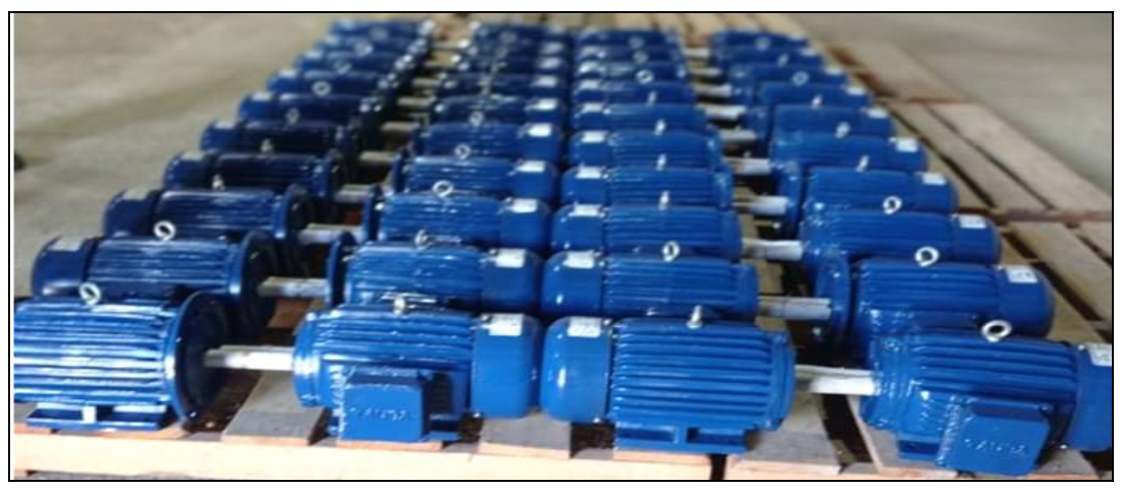Behavior of energy indices in a factory of electric motors for agriculture motors for agriculture
Main Article Content
Abstract
The present case study analyzes the relationship between the consumption of energy and the productions of the industrial sector for the agricultural sector, specifically those destined for AZCUBA. In this case, the manufacture of electric motors where the behavior of the currently established indicators is considered, taking into account the existing technology in the entity. The main objective of this work is to demonstrate that through an improvement in the energy management system, favorable impacts can be obtained both in the reduction of the physical consumption of energy and in the expenses associated with them. The importance of maintenance is considered in the course of work. The analyze methods are embodied in the Total and Efficient Energy Management Technology, a widely applicable work tool. The historical information on the consumption of the energy sources is used as a basis to establish the control of the energy involved in the production. In this case, emphasis is placed on the behavior of electric power, which is predominant in the energy structure of the entity.
Article Details

This work is licensed under a Creative Commons Attribution-NonCommercial 4.0 International License.
Aquellos autores/as que tengan publicaciones con esta revista, aceptan los términos siguientes:
- Los autores/as conservarán sus derechos de autor y garantizarán a la revista el derecho de primera publicación de su obra, el cuál estará simultáneamente sujeto a la Licencia de reconocimiento-no comercial de Creative Commons 4.0 que permite a terceros compartir la obra siempre que se indique su autor y su primera publicación esta revista. Bajo esta licencia el autor será libre de:
- Compartir — copiar y redistribuir el material en cualquier medio o formato
- Adaptar — remezclar, transformar y crear a partir del material
- El licenciador no puede revocar estas libertades mientras cumpla con los términos de la licencia
Bajo las siguientes condiciones:
- Reconocimiento — Debe reconocer adecuadamente la autoría, proporcionar un enlace a la licencia e indicar si se han realizado cambios. Puede hacerlo de cualquier manera razonable, pero no de una manera que sugiera que tiene el apoyo del licenciador o lo recibe por el uso que hace.
- NoComercial — No puede utilizar el material para una finalidad comercial.
- No hay restricciones adicionales — No puede aplicar términos legales o medidas tecnológicas que legalmente restrinjan realizar aquello que la licencia permite.
- Los autores/as podrán adoptar otros acuerdos de licencia no exclusiva de distribución de la versión de la obra publicada (p. ej.: depositarla en un archivo telemático institucional o publicarla en un volumen monográfico) siempre que se indique la publicación inicial en esta revista.
- Se permite y recomienda a los autores/as difundir su obra a través de Internet (p. ej.: en archivos telemáticos institucionales o en su página web) antes y durante el proceso de envío, lo cual puede producir intercambios interesantes y aumentar las citas de la obra publicada. (Véase El efecto del acceso abierto).
References
ABB Automation Power Products. (2019). Guía del motor: Información técnica básica de motores de inducción de baja tensión. Agenciase, Chile.
Agenciase- Chile. (2019). La importancia de la eficiencia energética para una agricultura más competitiva. Agencia de sostenibilidad energética, Chile. https://www.agenciase.org/2019/05/27/la-importancia-de-la-eficiencia-energetica-para-una-agricultura-mas-competitiva
Borroto, A., & Monteagudo, J. (2006). Gestión y economía energética. Editorial Universidad de Cienfuegos, 1(104), 6-16.
Borroto-Nordelo, A., Lapido-Rodríguez, M., Monteagudo-Yanes, J., de Armas-Teyra, M. A., Montesinos-Pérez, M., Delgado-Castillo, J., Padron, A., Viego-Felipe, P., & González-Pérez, F. (2005). La gestión energética: Una alternativa eficaz para mejorar la competitividad empresarial. Energética, 33, 65-69, ISSN: 0120-9833, Publisher: Universidad Nacional de Colombia.
Camarda, M. (2017). Eficiencia energética y competitividad industrial: Análisis del sistema de incentivos en torno al programa provincial energía eficiente (propee). Administración Pública y Sociedad (APyS), 3, 62-70, ISSN: 2524-9568.
Carretero-Peña, A. A. M., & García-Sánchez, J. M. (2012). Gestión de la eficiencia energética: Cálculo del consumo, indicadores y mejora. Aenor Ediciones, ISBN: 84-8143-752-2.
Colectivo de Autores. (2002). Gestión Energética Empresarial (Bajo la Redacción de Aníbal E. Borroto Nordelo ed., Cienfuegos, Cuba). Editorial Universidad de Cienfuegos, ISBN 959-257-040-X.
Colectivo de Autores. (2006). Gestión y Economía Energética. Centro de estudio de Energía y Medio ambiente, Universidad de Cienfuegos, provincia de Cienfuegos Cuba.
Machado, C. A. (2010). Gestión energética empresarial una metodología para la reducción de consumo de energía. Producción+ Limpia, 5(2), 107-126, ISSN: 1909-0455, Publisher: Área Metropolitana del Valle de Aburra.
MFP-Cuba. (2014). Resolución 277 Tarifas Eléctricas, no. PI-1-107, Ministerio de Finanzas y Precios [Resolución 277]. Ministerio de Finanzas y Precios, La Habana, Cuba.
MFP-Cuba. (2017). Resolución 435 Tarifas eléctricas. Ministerio de Finanzas Precios, La Habana, Cuba.
MFP-MINEN-Cuba (2018). Resolución No. 152/2018 (GOC-2018-657-EX61), La Habana, Cuba.
Molina, O. (2002). Guía teórico práctica de contabilidad de costos I. 2a. Mérida, Venezuela: Universidad de los Andes. Facultad de Ciencias Económicas.
NC –IS0 50001: 2011. (2011). Energy management systems-Requeriments with guidance for use. International Standart Organization ISO. Oficina Nacional de Normalización (ONN).
Olvera-Lobo, S. (2023). Programación y control del riego y fertilización del césped. AGAJ0308. IC Editorial, ISBN: 84-11-03317-1.
Pértega-Díaz, S., & Pita-Fernández, S. (2002). Determinación del tamaño muestral para calcular la significación del coeficiente de correlación lineal. Cuadernos de atención primaria, 9(4), 209-211, ISSN: 1134-3583, Publisher: Fundación Atención Primaria de Galicia.
Prias-Caicedo, O. F., Rojas-Rodríguez, D. B., & Palencia-Salas, A. (2019). Implementación de un Sistema de Gestión de la Energia, Guía con base en la NORMA ISO 50001 (Segunda edición). Universidad Nacional de Colombia.
Rizo, E. (2020). Irrigation Best Management Practices (Seis recomendaciones que harán más eficiente su sistema de riego). NESPAL, University of Georgia, USA. http://www. nespal.org/SIRP/IWC/all_prob/5.asp
Shock, C. C., Pereira, A. B., & Eldredge, E. P. (2007). Irrigation best management practices for potato. American Journal of Potato Research, 84, 29-37, ISSN: 1099-209X, Publisher: Springer.
Stubbs, M. (2016). Irrigation in US agriculture: On-farm technologies and best management practices.
